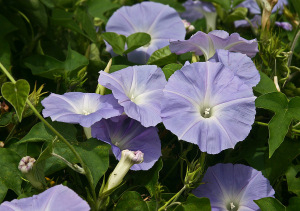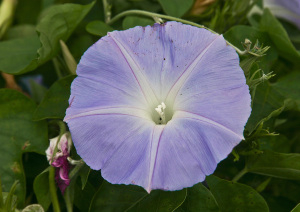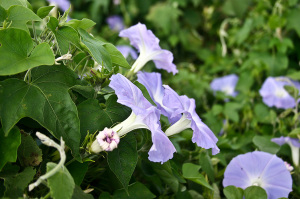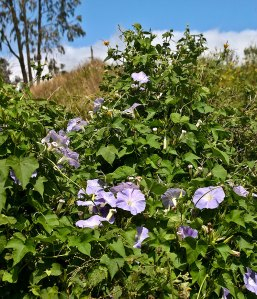I live on a part of the Island of Maui’s leeward shore that is surrounded by and engulfed in many small private and larger public gardens and parks. The enclosed courtyard of my own housing compound is a modest botanical garden that includes tall Coconut Palms, Strangler Figs, banana trees, and many of the flowering bushes and shrubs that grow on Maui. Despite competition from the usual hordes of gaudy hibiscus and orchid tree blossoms, the plants whose flowers stand alone in that crowd of colorful blossoms and foliage are the different species of the Zingiberaceae Family, or ginger.
Now that I’ve been photographing and blogging about Hawaii’s plant life, I’ve grown to appreciate the members of this plant family because of the great variety of their size, form, and color. It should be no surprise, then, that along with all of the photographs of palm trees and hibiscus, the online photo galleries of recent visitors to our islands are crowded with images of Hawaii’s photogenic ginger species.

Pink variety of Red Ginger (Alpinia purpurata). Flower head is about 20 cm long. Hana, east Maui.
(Click on image to see larger version.)
The English word “ginger” comes to us from the French word “gingimbre” by way of the ancient south Asian words “inji ver” (literally, “the root of Inji” in Dravidian) and “singivera” (Pali), from which the Greek word “zingiberis” and the medieval Latin word “gingiber” probably were derived. As you might expect, the Hawaiian names for individual species of ginger evolved along a different linguistic line.
Aside from being the ideal subjects for amateur photographers (unlike birds and whales, they tend not to move around much), the various species of ginger have long been known for their aromatic properties and as an ingredient in prepared ethnic foods. More recently, many “root ginger” species that belong to the taxonomic family Zingiberaceae have been found to possess chemical compounds sought after by the pharmaceutical industry. Zingerone, gingerols, and shogaols are the volatile oils (about three percent by weight) responsible for ginger’s fragrance, distinctive taste, and numerous beneficial medicinal properties.
Several extracts and distillations of ginger plants possess antibacterial, analgesic, sedative, and antipyretic (fever-reducing) medicinal properties. In addition, several species of ginger are currently being researched as candidates for the treatment and cure of skin and ovarian cancer. There is also on-going research into the blood-thinning and cholesterol-reducing properties of ginger. Powdered ginger root capsules have been shown to be effective in treating and preventing the nausea associated with morning sickness and motion sickness; however, clinical studies in this area have proven inconclusive.
The following are my photographs of a few of the most common species of ginger plants growing in Maui’s gardens and rain forests. These species also grow in the garden of my own housing compound in Kihei (leeward Maui).

Close-up of the flower head of a Torch Ginger (Etlingera elatior), Hana, east Maui.(Click on image to see larger version.)
Torch Ginger (Etlingera elatior), Hawaiian = ‘awapuhi ko‘oko‘o – A herbaceous perennial, individual plants grow in large clumps whose stalks can be as much as 6 m high with leaves as long as 85 cm. Although it is cultivated throughout the tropics and has escaped to become naturalized in some localities, its original native range is thought to be a few isolated islands in Indonesia. Typically it prefers a moist climate with somewhat acidic soil (pH = 5.6 to 7.5). It prefers full sun but does well in the partial shade of the rain forest. It is found at altitudes up to 9,000 feet. The various plant tissues and parts of this species of ginger are rich in volatile aromatic compounds. The majority of the essential oils extracted from the leaves, stems, flowers, and rhizomes of Torch Ginger are monoterpene hydrocarbons. Terpenes are the primary constituents of the essential oils of many types of plants and flowers. Essential oils are used widely as natural flavor additives for food, as fragrances in perfume, and in traditional and alternative medicines. Synthetic variations and derivatives of natural terpenes and terpenoids also greatly expand the variety of aromas used in perfumery and flavors used in food additives. Vitamin A is an example of a terpene. Currently, this and other species of ginger are the subjects of extensive research into the various antioxidant compounds present in their leaves and rhizomes.

Crepe Ginger (Costus speciosus), Keanae Peninsula. The fluted “petal” is actually the male part of the flower. (Click on image to see larger version.)
Crepe Ginger (Costus speciosus) – This species is a native of the Greater Sunda Islands of Indonesia and the Malay Peninsula. Although it has become naturalized in the Hawaiian Islands, its invasive tendencies enable it to crowd out native species. Its preferred habitat is moist fertile soils and partial sun, but will grow well in full sun if it gets plenty of moisture. One of the most cold-hardy of the gingers, it has been shown to withstand freezing temperatures as low as 17 degrees Celsius. Crepe Ginger is a tall and substantial-looking plant with large (15-30 cm long by 5-7 cm wide) dark-green leaves arranged on the stalk in a spiral. This species can grow to more than 3 m tall under ideal soil and climatic conditions. The unusual-looking flowers bloom throughout the year in tropical climates, but only in late summer to early fall in colder conditions. The flower’s single ,petal (actually the male part of the flower) looks like crepe paper, hence the common name “Crepe Ginger”. This and other ginger species propagate most effectively by producing a large network of thick fleshy rhizomes that are similar in appearance to the “ginger root” sold in grocery stores and at farmer’s markets. A single rhizome will produce new shoots and grow into a clump more than one meter in diameter in less than two years. Traditionally, the rhizome has been used to treat fever, rash, asthma, bronchitis, and intestinal worms. In India and Southeast Asia, this species is still used to treat boils, constipation, diarrhea, dizziness, headache, and vertigo (“seasickness”). This species is also a source of diosgenin, a compound used for the commercial production of clinically important steroids such as progesterone.

White Ginger (Heydychium coronarium), Hana, east Maui. (Click on image to see larger version.)
White Ginger, Ginger Lily (Hedychium coronarium), Hawaiian = `awapuhi ke`oke`o – A native of India, it was exported throughout the tropics because of its popularity as an ornamental species. It soon escaped the confines of private gardens and became naturalized throughout the Hawaiian Islands. It is considered an invasive weed because of its ability to propagate quickly by sending out many shallow roots (rhizomes) in all directions, creating dense thickets of individual plants. This creeping growth quickly overwhelms and crowds out other low-growing plant species. Hedychium coronarium is a perennial herb that can grow as two meters in height. It prefers moist habitats, such as rain forests, the banks of streams, moist forest, roadsides, and open fields and pastures. It has large (30 cm long by 10 cm wide at maturity) simple elliptical or lance-shaped leaves. It produces large numbers of flowers throughout the year. The fragrant white flowers are borne on long (10-20 cm) elliptical spikes in groups of two to six flowers atop a leafy stem. The fruit is borne in an oblong many-seeded capsule, but is not usually present or easily seen since propagation of the species is usually accomplished by spreading rhizomes.

Indonesian Wax Ginger (Tapeinochilos ananassae). Flower head is about 25 cm long. Well adapted to the moisture and shade of Maui’s rain forests.
(Click on image to see larger version.)
Indonesian Wax Ginger or Pineapple Ginger (Tapeinochilos ananassae) – Like other ginger species growing in Hawaii, this plant was introduced for its ornamental attributes: a large, showy inflorescence and beautiful foliage. Its foliage consists of thick, jointed bamboo-like stems that grow directly from numerous rhizomes. The long, smooth, lance-shaped leaves are arranged on the stem in an inward-curving spiral typical of this species; the leaves radiate outward from the spiral. The small yellow flowers (which function as attractors to pollinating insects and birds) are aggregated in a large (10-30 cm long), bright-red pineapple-shaped terminal spike consisting of what appear to be waxy bright red flower petals, but are actually bracts (modified leaves that enclose the actual flower). To reach its full height (about 3 m), this species requires very high humidity. It prefers the full shade and moist, fertile, well-drained soils of the rain forest. Unlike many other tropical ginger species, this plant possesses no aromatic essential oils.

Scarlet Spiral Flag Ginger (Costus woodsonii), Hana Maui Botanical Gardens, east Maui.
(Click on image to see larger version.)
Scarlet Spiral Flag Ginger, Indian Head Ginger, or Red Button Ginger (Costus woodsonii Maas), Hawaiian: ‘awapuhi ‘inikini po‘o – This species has gently spiraled stems and grows to about a meter in height. The leaves are deep green. The bracts of the inflorescence are bright waxy red, forming a pine cone-like spike (10-15 cm long) from which the yellowish-orange flowers protrude outward one at a time. The numerous small black seeds (1-2 mm long, the smallest of the true gingers) are usually dispersed by birds, but it is possible that they are also dispersed by water if the plant is growing in a wetland environment. C. woodsonii is an aggressive and invasive species. Its rhizomes spread rapidly and, once established, they are difficult to remove. This species grows well in full sun, flourishing even in the sandy soils and dune sands of tropical coasts, but it prefers the shade, ample moisture, and deep, fertile soil of the rain forest. Although the genus Costus sp. is found throughout the tropics on all continents, this species was first collected and described in Panama in 1941. It was an introduced ornamental garden plant that became a naturalized escapee in some parts of Hawaii. It is considered to be an invasive weed on Oahu, Maui, and Kauai islands. It is present in large but widely scattered populations at low elevations on Maui, particularly along the Hana Highway. This species also displays a classic behavior of species mutualism: it exudes what is known as “extrafloral nectar” from the bracts of the flower spike, attracting ant species that harvest the nectar. In turn, the ants protect the plant from the larvae of flies and other flying insects that lay their eggs in the flowers.

The pink variant of Red Ginger (Alpinia purpurata), a garden in Kihei, south Maui. (Click on image to see larger version.)
Red Ginger (Alpinia purpurata), Hawaiian = ‘awapuhi ‘ula‘ula – Originally a native of Southeast Asia, A. purpurata was introduced to Hawaii as an ornamental species in 1928; it is now naturalized. Grows to about 3 m tall in the wild (can grow to more than 9 m tall under cultivation) and forms large clumps of foliage bearing large oblong leaves (30-80 cm long by more than 20 cm wide). As with other ginger species, the large inflorescence (15-30 cm long, getting longer as the plant ages) consists of brightly colored (usually pink or red, occasionally white) bracts that look like a bloom, but the true flower is a small white blossom (corolla) at the outermost tip of the inflorescence. The fruit is a globular seed capsule about 3 cm in diameter that contains numerous small seeds (2-3 mm long). Although this species of ginger will tolerate direct sunlight, it requires very high humidity and soil moisture, as well as warmer air temperatures (more than 50 degrees F) to grow to its full size. Research has revealed that this species is a possible natural source for bioactive compounds useful for the treatment of hypertension.
Tags: Alpinia, beneficial medicinal properties, bioactive compounds, botany, botany of Hawaii, botany of Maui, bracts, cholesterol-reducing properties, Costus, Costus speciosus, Costus woodsonii, Crepe Ginger, diosgenin, Etlingera, extrafloral nectar, flowering plants, ginger, ginger root, Hawaii, Hawaiian plants, Hedychium, invasive species, Maui, Maui’s plants, medicinal properties, nature photography, pharmaceutical plants, Pineapple Ginger, plant life of Hawaii, plants of Hawaii, plants of maui, progesterone, rhizomes, Tapeinochilos, Terpenes, Torch Ginger, treatment of hypertension, tropical plants, Wax Ginger, White Ginger, Zingiberaceae


























